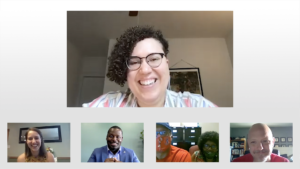“vigilance against the new appearance / of old growth / has never been enough / we must rewrite the ground”
—Laura Eve Engel
If true justice were achieved, how would we recognize it? When we do seek it, what outcomes do we envision? Since joining Illinois Humanities’ Envisioning Justice initiative in the spring of 2020, I’ve considered these questions every day: in the wake of George Floyd’s murder and into the ensuing uprisings, through the battle for and passage of Illinois’s landmark criminal justice reform bill, and as my friends and colleagues fight each day for a better world than the one we inherited.
On the Envisioning Justice team, we’re fortunate to share a common notion of what justice isn’t. In everything we do, we try to center a philosophical understanding that true justice is a multifaceted progress narrative, a future to work toward rather than a single goal that can be reached overnight; and that as long as our nation’s understanding of justice requires punishment through the criminal legal system in the form of mass incarceration, that future will remain unattainable. We speak often of the ways legal punishment extends beyond mere imprisonment: how imprisonment is itself a traumatic experience that usually compounds existing trauma, and how a sentence of incarceration is never purely a sentence, but rather a lifetime of systematic exclusion from citizenship. With these as our guiding tenets, we work to create opportunities and environments rooted in the humanities and the arts that generate alternatives to this brutal system which disproportionately harms Black, Indigenous, and people of color (BIPOC) and other economically marginalized communities.

I spent my earliest days at Illinois Humanities speaking with people across the state with broadly defined ties to the carceral system, a term which denotes the entirety of our nation’s vast network of involuntary detention facilities in conjunction with the institutions that feed into it. Through interviews in Bloomington-Normal, Carbondale, Chicago, Decatur, East St. Louis, Galesburg, and Urbana-Champaign as part of Illinois Humanities’ Visions of Justice video series, I’ve been fortunate to build relationships with passionate advocates for change who fight for a just future in our state. From artists to historians, social workers to lawyers, journalists to organizers, scholars to policymakers—many of whom have been incarcerated in prisons and jails themselves—I met Illinoisans statewide who struggle daily for those whose lives and families have been affected by the system. In all 35 of the interviews I conducted across these seven towns and cities, I asked contributors to consider their own notions of justice and to describe what in our society would need to change in order for Illinois to become truly just. A full year after recording the Visions of Justice interviews, justice still feels like a slippery concept, changing from person to person, dependent wholly on the individual experiences and beliefs that comprise their perspective.
Contributors to the series came to a swift consensus about what injustice looks like: As several contributors reminded me, one need look no further than the alarming statistic that despite the rate of crimes committed being equal across racial groups, and that our Black and Latinx communities comprise only 20% of the U.S. population, the Black and Latinx populations combined also make up roughly 60% of the 2.3 million currently incarcerated in the U.S. (1) Or, more locally, Illinois’s incarcerated population rose by 169% between 1983 and 2015, and despite representing only 15% of the state’s population Black people made up 56% of Illinois’s prison population as of 2017.(2) Beyond that, an additional 4.9 million people nationwide have been incarcerated in the past, with the result that roughly one out of every two Americans has a family member who has spent time in prison or jail in their lifetime.(3)
Another way to phrase my questions might be: Why does punishment in the form of widespread incarceration seem like the only just solution to the complex socioeconomic and racial dynamics of crime?
Even after setting statistics aside, from a purely legal standpoint, for hundreds of years of U.S. history the defining injustice has been the persistent reality that our BIPOC communities have been subject to a different understanding of justice than that reserved for the U.S.’s white majority. This history is well documented, from the infamous 1857 Dred Scott v. Sandford decision that disavowed Black citizenship, to the extensive legacy of legally sanctioned extrajudicial executions in the form of lynchings, to the trial following Trayvon Martin’s murder that hinged on the question of which party was legally entitled to stand his ground. Without even scratching the surface, examples of injustice abound.
I came to this project with a clear concept of what injustice looks like, but my concept of justice gets muddier every day. Maybe there won’t ever be one nationally approved definition of justice. But I’ve come to understand, through Visions of Justice, that while it may be difficult to establish a shared vision that feels and looks and sounds like justice, we can always work alongside each other to ensure the injustices of our era do not survive to define someone else’s. Justice for me will never mean locking someone up. But in the meantime, the EJ team will continue to use the arts and humanities to encourage the radically imaginative work needed to create a better future for our state. Visions of Justice contributes to that work; much more is needed to complete it.
Throughout Fall 2021, Illinois Humanities will host virtual screenings of the Visions of Justice video series paired with panel discussions focused on the communities of Bloomington-Normal, Carbondale, Chicago, Decatur, East. St. Louis, Galesburg, and Urbana-Champaign. Click here to watch the series as it unfolds and register for events.
(1)Prison Policy Initiative, “Racial and ethnic disparities in correctional facilities” (2018)
(2)Vera Institute of Justice, “Incarceration Trends in Illinois” (2019)
(3)Equal Justice Initiative, “Half of Americans Have Family Members Who Have Been Incarcerated” (2018)